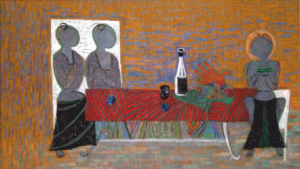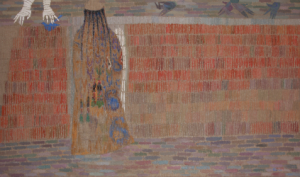Dildora Umarova,
Art Critic
 Over the years of the country’s independent development its young artists have enjoyed every opportunity to receive education and portray life of the nation, combining the study and representation of its heritage, rituals and traditional lifestyle denoted by ancient symbols, mysterious meanings and achievements of the modern world. Gairat Ibragimov, member of the Artists Union of Uzbekistan, is one of the young talented artists exploring visual arts such as painting, drawing, installation and video-art. His work is known for original colour solutions, and bold combination of oriental culture elements with modern representational techniques.
Over the years of the country’s independent development its young artists have enjoyed every opportunity to receive education and portray life of the nation, combining the study and representation of its heritage, rituals and traditional lifestyle denoted by ancient symbols, mysterious meanings and achievements of the modern world. Gairat Ibragimov, member of the Artists Union of Uzbekistan, is one of the young talented artists exploring visual arts such as painting, drawing, installation and video-art. His work is known for original colour solutions, and bold combination of oriental culture elements with modern representational techniques.
 In his “Caravan” (2006), “Awakening” (2008), “Oriental Motifs” (2008) and “Children of the Sands” (2010) Ibragimov reflects on important matters of existence shown through historical illusions and real plastic forms of modern day. His works, along with strong colour symbolism, reveal mystical connections and deep new reflections. They express a tendency characteristic of the modern Uzbek painting of abstracting from reality and abandoning the usual story-line and character connections in favour of a symbol and more intense metaphorisation of the poetic idea.
In his “Caravan” (2006), “Awakening” (2008), “Oriental Motifs” (2008) and “Children of the Sands” (2010) Ibragimov reflects on important matters of existence shown through historical illusions and real plastic forms of modern day. His works, along with strong colour symbolism, reveal mystical connections and deep new reflections. They express a tendency characteristic of the modern Uzbek painting of abstracting from reality and abandoning the usual story-line and character connections in favour of a symbol and more intense metaphorisation of the poetic idea.
In “Awakening” (2008) and “Echoes of the Sky” (2007), connection with the past is expressed not only through symbols and visual associations, but also through emotional contact and some kind of a ‘heroic’ note, like in an ancient epic tale.
Ibragimov’s painting is inherently metaphorical. The viewer is presented with the world through the prism of the artist’s subjective perception, rather than the way it really is. The author achieves this by changing the colour, shape and function of the object. In his “Pomegranate Season” (2006), “Pomegranate Dialogue” (2007) and “Pomegranate Flirt” (2007) the emphasis is on the inner spiritual culture, rather than on small details. The artist seems to expose his soul to the viewer.
Conventional world of metaphor shows in his paintings “At the Movies” (2007) and “Passport Photo” (2007). Expressive sound, intensified dynamic rhythm, and great emotional charge in Ibragimov’s art came forth under the influence of a new atmosphere in art. Among such paintings are “A Girl Wearing Adras” (2007), “Music of the Ancestors” (2007), and “Oriental Motifs” (2008). The canvas decorative beauty reveals the author’s heartfelt experiences as well as concentrated semantics and symbolic generalization. For instance, in the vivid and expressive painting of “Echoes of the Sky” (2007), “The Spirit of Fertility” (2009) and “The Spirit of the Steppes” (2010) ancient history and myths are combined with poetic imaginings and contemporary issues.
In some paintings of the artist (“Oriental Gardens”, 2010) one can find irony and fantastic exaggeration. He skilfully stylizes reality as fantasy, combining things incompatible and paradoxical, and he does it all under the laws of a large classic painting. In general, his painting is perceived as something mythical. In his mysterious canvases the world appears to hold secrets and anxieties, untamed and frightening elemental forces and energies, to be the concentration of revelations about history, civilization and man’s place in it.
 The artist remarks: “I wish to briefly explain what an invert painting is, or how I arrived to the Invert (negative or reverse image) solution in painting. After a long searching and numerous experiments I suddenly came up with an idea of a simple still-life, which opened a new perspective in my art, primarily in colour solution. For the start, I painted from living nature, while imagining everything in inversion. Without employing any technology but guided by my own vision, I made my manner more complex. Some things did hit the mark, while others didn’t: in this I find the colour challenge and new horizons to explore solutions for compositions and shapes. The search for solutions and painting experiments gave rise to the idea that took me to a new phase in my art. Combining cold spectrum colours with warm ones, darker and lighter shades, I discovered the “negative positive effect”.
The artist remarks: “I wish to briefly explain what an invert painting is, or how I arrived to the Invert (negative or reverse image) solution in painting. After a long searching and numerous experiments I suddenly came up with an idea of a simple still-life, which opened a new perspective in my art, primarily in colour solution. For the start, I painted from living nature, while imagining everything in inversion. Without employing any technology but guided by my own vision, I made my manner more complex. Some things did hit the mark, while others didn’t: in this I find the colour challenge and new horizons to explore solutions for compositions and shapes. The search for solutions and painting experiments gave rise to the idea that took me to a new phase in my art. Combining cold spectrum colours with warm ones, darker and lighter shades, I discovered the “negative positive effect”.
Since 2007 Ibragimov has created several video-art pieces. Among them are “Dollan Maqam” (2007), “The Spirit of the Steppes” (2007), “Breakthrough” (2008), “The Genes of Turkistan” (2009), and “Children of the Sands” (2010), in which video and painting form an integral series of pictures. The basic idea and concept of the artist’s video-art is in one quarter his inner world of fantasies that prompt the conception of a picture. The very idea of making videos is simple: the viewer should understand it without words.
Video-art is easy to perceive for any audience through a few minutes explanation that provides food for thought, complementing impressions from a painting and exciting interest of a viewer who may sometimes have little concern for the world of art.
In the “Turkistan Remake” project (2009) presented at the V Tashkent International Biennale of Contemporary Art the original solution for “The Genes of Turkistan”, which was based on old photographs from the Turkistan Album published in 1871-1872, enabled the artist to create video and painting showing the past, the present and the future of an oriental woman, her life and destiny, traditions of her family, society and the world at large. The main objective of the project was to demonstrate the possibility of a new interpretation of the recent history strata by contemporary artists in terms of exposing the uniqueness of characters, people’s lives and the atmosphere of the past.
 Ibragimov’s art has many facets; it easily balances between abstraction and realism. The author is in harmony with several visual art forms and trends at once, which underlies his continuous searching and refining of his signature style. His art is realist for the avant-garde, while too conventional for the realist manner. Ibragimov’s works were presented to the wide audiences in collective and solo exhibitions.
Ibragimov’s art has many facets; it easily balances between abstraction and realism. The author is in harmony with several visual art forms and trends at once, which underlies his continuous searching and refining of his signature style. His art is realist for the avant-garde, while too conventional for the realist manner. Ibragimov’s works were presented to the wide audiences in collective and solo exhibitions.
Ibragimov had his solo exhibitions in 2001 in Germany (Taufkircher); in 2004 in Austria (Vienna), at the Artist in Residence Federal Government House; in 2005 in France (Paris), at the Cite Internationale des Arts; in 2005 in Hungary (Göd), at the Olaijfa Tuveszhaz Gallery; in 2008 in Uzbekistan (Tashkent), at the House of Photography; in 2009 in South Korea (Seoul); and in 2013 again in Uzbekistan (Nukus), at the Karakalpakstan State Art Museum named after I. V. Savitsky.
The works of Gairat Ibragimov are kept in museums in countries such as Hungary (Budapest, Museum of East Asia), Kyrgyzstan (Bishkek, the Chuikov State Art Museum), Russia (Moscow, State Museum of Art of Oriental Nations), Uzbekistan (Tashkent, State Art Museum; Nukus, Karakalpakstan State Art Museum named after Savitsky), as well as in private collections.
References
1. Constallation. Postscriptum. Ташкент, 2007.
2. Искусство наций. Молодость. Второй Форум творческой и научной интеллигенции государств – участников СНГ. Астана, 2007.
3. Гайрат. Каталог. Ташкент, 2010.
